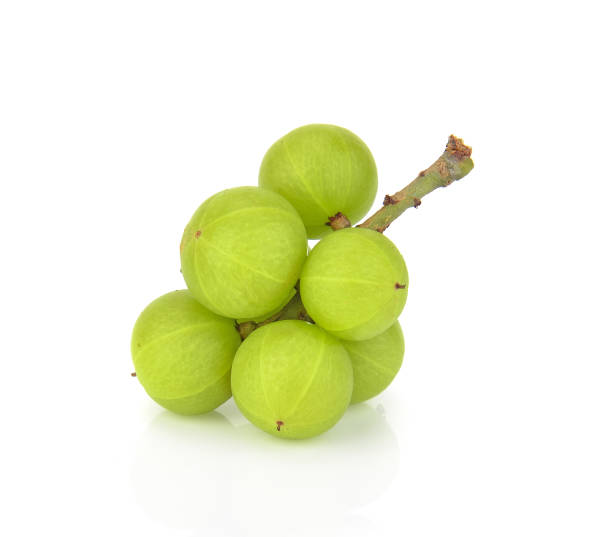Amla Osteoporosis, Osteopenia herb.
Amla Osteoporosis , Osteopenia reversing herb is native to India. Its Botanic name is Phyllanthus emblica. And it is also called Emblica officinalis.
In Sanskrit, this herb is called Amalaki or Dhartiphala. It has several 'popular names' : Indian Gooseberry, Emblic myrobalan, Amla and Amalaki. (NOTE: I mention all these names since the herb may be sold under any one of them. It may not always be called Amla.)
In India the Amla tree has been regarded as a sacred for many years. It was worshipped as Mother Earth and it is believed to nurture humankind because its nourishing fruits.
Description. The herb has gray bark. Its leaves are feathery and smell like lemon. Amla flowers in Spring and has greenish yellow flowers. Fruit starts to develop by mid-spring and these fruits ripen towards early autumn. The fruit looks very much like Gooseberry, hence it is sometimes named: Indian Gooseberry.
As for its healing properties, Amla is used for many different conditions:
1. There are several animal studies showing that an extract of this Amla reduces oxidative stress to the liver.
2.The herb has restored levels of glutathione and superoxide dismutase, two important anti-oxidants.
3. It is used to treat gastrointestinal disorders and colitis
4. And it is sometimes used to prevent early graying of hair
How Amla is used for building bone
Amla is often used as a decoction and infusion of leaves and seeds. It is also used as a liquor, an essential oil; a confection; a powder and a paste. The one caution you need to be aware of is that some people (Pita doshas) can experiences acute diarrhea when using Amla. So if you get diarrhea after taking the herb, stop using it.
Special caution about using Amla
Amla may be beneficial but there are some people who should NOT use it.
- some allergic people, intake of Amla products can increase the risk of bleeding.
- For a diabetic patient, Amla should be taken with proper precautions as its intake can drastically drop blood sugar levels. (Ask your doctor before using.)
- The dosage of Amla juice can lead to dryness of the skin.
- Amal should be avoided during coughing or aggravated Kapha problems.
- Amla is not recommended during and after surgery, as it might increase the risk of bleeding.
If you have a bleeding disorder or are diabetic, please either do not use Amla or consult your health care provider before doing so.
Studies concerning effectiveness: Amla Osteoporosis, Osteopenia treatment.
In 2008 the Journal of Complimentary Alternative Medicine published an article concerning the Amla for the treatment of Osteoporosis.
This article is titled, Induction of apoptosis of human primary osteoclasts treated with extracts from the medicinal plant Emblica officinalis (Amla) and it presented research done by Letizia Penolazzi, Ilaria Lampronti and Roberto Gambari.
In their study these researchers found that Amla induced Osteoclasts cells to programmed cell death. Since Osteoclasts are our bone removing cells, their death would mean that less bone is removed. As a result bone density can increase. This is the same mechanism used by a number of pharmaceutical drugs such as the bisphosphonate class of drugsl
Big Caution. If you have a BLEEDING DISORDER of any kind, do not use amla before consulting your health care provider. Also, do not use it if you are going to have surgery.
Who should not take amla?
If you have a bleeding disorder, either do not use Amla, Indian gooseberry or use it with caution. Best to check with a physician who knows the herb. If you are going to have Surgery: Indian gooseberry might increase the risk of bleeding during and after surgery. Stop taking Indian gooseberry at least 2 weeks before a scheduled surgery. If in doubt, ask your surgeon.
If you wish to read the published article about Amla in its entirety just click on Amla Osteoporosis, Osteopenia herb from India
Or, if you want, here is a web site that gives a great deal of information about ALL the uses of Amla
If you are near an Indian grocer or herbalist, it may be worth asking about Amla. If you have not used it before, be sure to buy only a small quantity until you are certain that you will not be one of those who sometimes have a negative reacting to this powerful herb. (No use wasting money.) If you do not live in India or have little connection with Indian culture, Amla may be very new to you but for those in or from India, it is well known.
Click here to read more Alternative Medicine treatments for bone loss.
Want to buy Amla?
Amal is available at Amazon. And if you buy it from the link on this web site, Amazon will give me a small percent of your order. You can search Amazon by clicking on this link: Amazon

Have you experience with this?
Do you have experience with this? Please share it!
